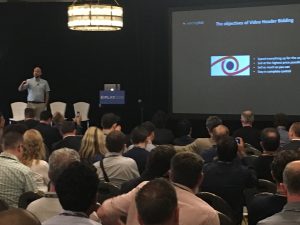Cameron Church talks about the importance of video in advertising, the challenges, and the way forward.
Know My Team
Who is Watching That?
Watching That is the world’s first software platform that leverages big data and Machine Learning to ensure businesses get the most views, money and success from online video. With over $145 billion spent annually in digital video advertising, there’s a lot at stake. Unlocking only a slice of this pot means millions of dollars in reward — Watching That is the key.
What kind of clients do you work with and what services do you provide?
Watching That works with premium media organizations from across the globe, such as newspapers, magazines, broadcasters and digital natives.
The formula to online video success is relatively well known — produce great videos, get them seen by those that matter, maximize your business return from each of those views, and do it all at scale while operating at high speed.
What is unknown is how to achieve those outcomes and the answers to questions such as: How do you know what your audience wants to watch? Where do you find your target audience and stand out from the crowd? How to ensure the experience is top notch to maximize their openness to your attempts to extra value (by advertising, etc)? How do you keep across everything while you’re trying to do everything else? Watching That provides the answers to all those questions and more.

Why do you believe video is so important in advertising?
If advertising is all about informing, persuading and reminding people about your products and services, then there is simply no better medium than video to do this. Video is fully captivating — while you watch a video, you’re not able to do anything else. It also enshrines your message, so that no matter where it travels: mobile, desktop, TV, etc, the core message is completely intact with its integrity ensured. And the richness of this messaging that can be delivered across sight and sound is unparalleled. Video, when done right, is second only to being there.
What are the current challenges facing the industry in regards to video advertising?
There are many challenges facing the industry and they are constantly changing. Alongside not fully understanding how to go about being successful, there are external pressures on the industry such as GDPR, Autoplay Restrictions, Brand Safety, Viewability, Vertical Ad Formats, Skipabble Ads.
There are also more nuanced challenges such as ensuring your demand partners are behaving properly, that creative files are correct, and that you’re not taxing your user too much while trying to ensure the high value for the inventory. Suffice it to say there are many challenges that impact video advertising. Fortunately, the prize is even bigger so it’s always worth the effort.

Why should advertisers be taking more notice of video analytics and why do you think so many advertisers and marketers aren’t currently doing so?
Ultimately, those that know what’s going on have an unfair advantage over those who do not and analytics is the difference between the states of unknowing and knowing.
Those that leverage the data and insights supplied by intelligent platforms like Watching That will be the ones that succeed as they will be able to react more quickly when things go wrong. They will be able to spot and unlock more opportunities faster than the competition and do it all in a much easier way.
I do think that advertisers and marketers have been aware of video analytics for a long time, I just don’t think that a specialist, purpose-built platform has emerged until Watching That launched. Up until then, everyone had to rely on complex spreadsheets and generic tools to try and get a glimpse into the workings of the complex beast that is their video operations.
At the early, expansive times of the industry, you could get away with this. However, now it’s much more competitive and rational. Everyone across the supply chain wants positive ROI so there is now a demand for unifying insights to allow video businesses to reach the next level.

How can advertisers leverage video analytic insights in the way they publish and share video ads?
There are 3 broad ways:
- Monitoring real-time activity — Having a heartbeat to your video ad inventory is crucial to ensuring your viewers are getting the best experience possible. And when things do start to go wrong, you can jump on it well before those problems impact your business.
- Troubleshooting issues — Things can go wrong, a lot. But getting to the source of the error can be a real challenge. There are so many systems involved in delivering an enjoyable viewing experience and when something has gone wrong you need to be able to get to the cause quickly. That can mean looking across many dimensions of data and how it all joins together. Watching That collects and correlates over 100 data points across the entire technology stack, in real-time, to get you to the source of any problem.
- Learn and get better – Video ads have an end objective, they are meant to achieve something. Video analytics should allow you to track how well they achieve their purpose and, more crucially, the analytics should let you understand what has and has not worked.
How have emerging technologies, such as Artificial Intelligence, impacted the way marketers and advertisers use and understand video marketing?
AI is letting everyone, marketers and advertisers included, do more with less. AI allows for the automation of previously manual jobs — indeed, the power of AI techniques such as Machine Learning are a real game changer as it’s also opening up access to insights that can’t be derived by humans alone. The biggest value add from AI in this space though is the ability to sift through oceans of data to find all the key insights, assess them for opportunities (albeit at a basic level), and alert the human operators to their existence. This means so much more can be achieved with the same level of investments.
Where do you see the future of video advertising going? Will it still be as impactful as an advertising tool as it is now?
More so. Over the horizon there is a gamut of VR and AR technologies getting ready for their prime time and they are fundamentally video at their core. Video advertising is ripe for an offline and online renaissance. From the digital poster to the TV and from the mobile phone to the visual overlays you’ll get in AR headsets, the thing that binds them all is the video format. As a marketer what medium, other than video, lets you reach your audience so conclusively and so effectively than video?
Thank You, Cameron, for answering all our questions. We hope to see you again at MTS, soon.




Comments are closed.